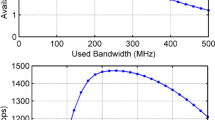Abstract
Optical signal reinstatement (OSR) is a common technique used in high-speed communication systems. OSR can be achieved using various techniques such as; semiconductor optical amplifiers, optical parametric amplifiers, optical loop mirror, and etc. The existing OSR techniques of a maximum speed of 40 Gb/s for long haul communication of 300 km transmission distance offer the 10−10 BER of and noise (phase and amplitude) mitigation. Presently, the existing OSR techniques require low BER, strong noise rejection for more than 40 Gb/s degraded signal. In this work, optical signal restoration technique is developed for 100 Gb/s degraded signal for 400 km transmission distance. The proposed technique is designed using 2R and PSA. The benefit for using 2R with PSA is that 2R (re-amplify regenerate) the signal, while PSA is used to mitigate the amplitude and phase noises respectively. The developed technique is implemented for DPSK-RZ transceiver system and offers the BER of 10−21 and noise mitigation of more than 90% for DPSK-RZ transceiver system.


















Similar content being viewed by others
References
Hecht, J. (2015). Understanding fiber optics. Seattle: CreateSpace Independent Publishing Platform.
Djordjevic, I. B., Minkov, L. L., & Batshon, H. G. (2008). Mitigation of linear and nonlinear impairments in high-speed optical networks by using LDPC-coded turbo equalization. IEEE Journal on Selected Areas in Communications, 26(6), 73–83.
Lucek, J. K., & Smith, K. (1993). All-optical signal regenerator. Optics Letters, 18(15), 1226–1228.
Louis, P. F. (1972). U.S. Patent No. 3,671,875. Washington, DC: U.S. Patent and Trademark Office.
Connelly, M. J. (2007). Semiconductor optical amplifiers. New York: Springer.
Andrekson, P. A., Petropoulos, P., Radic, S., Peucheret, C., & Jazayerifar, M. (2015). Fiber optical parametric amplifiers in optical communication systems. Laser and Photonics Reviews, 9(1), 50–74.
Das, B., Abdullah, M. F. L., Shah, N. S. M., Ahmed, L. M. A., & Pandey, B. (2017). Development of new all-optical signal regeneration technique. Wireless Personal Communications, 95(2), 523–537.
Das, B., Abdullah, M. F. L., Chowdhry, B. S., & Shah, N. S. M. (2017). A novel signal regeneration technique for high speed DPSK communication systems. Wireless Personal Communications, 96(2), 3249–3273.
Willner, A. E., Khaleghi, S., Chitgarha, M. R., & Yilmaz, O. F. (2014). All-optical signal processing. Journal of Lightwave Technology, 32(4), 660–680.
Weik, M. (2012). Fiber optics standard dictionary. New York: Springer.
Rohde, M., Caspar, C., Heimes, N., Konitzer, M., Bachus, E. J., & Hanik, N. (2000). Robustness of DPSK direct detection transmission format in standard fibre WDM systems. Electronics Letters, 36(17), 1483–1484.
Das, B., Abdullah, M. F. L., & Shah, N. S. M. (2017). Development of all optical signal regeneration method for 100 Gb/s differential phase shift keying degraded signal. In 9th international conference on robotic, vision, signal processing and power applications (pp. 527–534). Singapore: Springer.
Marcuse, D. (1983). Classical derivation of the laser rate equation. IEEE Journal of Quantum Electronics, 19(8), 1228–1231.
Andre, P. S., Pinto, A. N., Pinto, J. L., & da Rocha, F. (1999). Extraction of DFB laser rate equations parameters for optical simulation purposes. Conftele, 99, 561–564.
Senior, J. M., & Jamro, M. Y. (2009). Optical fiber communications: Principles and practice. Madison: Pearson Education.
Van Liet, D. (Ed.). (2012). Nonlinear optical systems: Principles, phenomena, and advanced signal processing. Boca Raton: CRC Press.
Le, N. B. (2015). Advanced digital optical communications. Philadelphia: Taylor and Francis.
Lutovac, M. D., Tošić, D. V., & Evans, B. L. (2001). Filter design for signal processing using MATLAB and mathematica. Upper Saddle River: Prentice Hall.
Le, N. B. (2013). Digital processing: Optical transmission and coherent receiving techniques. Boca Raton: CRC Press.
Acknowledgements
The authors express their gratitude to Universiti Tun Huseein Onn Malaysia and Department of Electronic Engineering, Quaid-E-Awam University of Engineering, Science and Technology, Nawabshah, Sindh, Pakistan for their support.
Author information
Authors and Affiliations
Corresponding author
Rights and permissions
About this article
Cite this article
Das, B., Abdullah, M.F.L., Pandey, B. et al. Design and Implementation of Optical Signal Reinstatement Technique for High DPSK RZ Transceiver Scheme. Wireless Pers Commun 106, 1767–1786 (2019). https://doi.org/10.1007/s11277-018-5605-9
Published:
Issue Date:
DOI: https://doi.org/10.1007/s11277-018-5605-9




